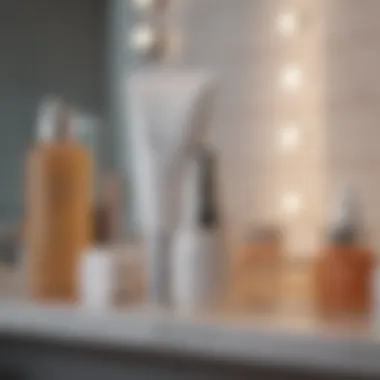Understanding Pimples on the Neck and Jawline


Intro
Pimples on the neck and jawline can be a troubling issue for many individuals. Often overlooked, these breakouts can stem from various factors, such as hormonal changes, skin type, and personal grooming habits. Understanding the irritants and conditions that lead to these skin issues is crucial for effective management and prevention. This article aims to shed light on the complexities surrounding acne in these specific areas while providing practical solutions that cater to diverse skin types and lifestyles.
Here, we will explore classical causes, debunk myths about skin health, and suggest a variety of treatments. Each step is designed to provide a comprehensive understanding of how to regain clear skin on the neck and jawline.
Preamble to Facial Acne
Understanding facial acne is crucial as it lays the foundation for comprehending the specific issues relating to pimples on the neck and jawline. This section serves as an introduction to the complexities of acne, a prevalent skin condition that affects individuals across different ages and backgrounds. By defining facial acne and addressing common misconceptions, readers can gain valuable insight into why breakouts occur and what factors contribute to them.
The information in this part of the article provides a backdrop for the more specific discussions that follow. Recognizing the nuances of acne can empower individuals to take appropriate action when they face this skin concern, enhancing their overall skincare knowledge.
Definition of Facial Acne
Facial acne is a chronic skin condition characterized by the presence of pimples, blackheads, and cysts primarily caused by the clogging of hair follicles. Hormones, bacteria, and excess oil production are common culprits in this process. It manifests mainly on the face, but it can appear on other areas such as the neck and jawline.
In essence, acne is not merely a cosmetic issue; it can have psychological impacts as well, affecting self-esteem and emotional well-being. Therefore, accurate understanding of its definition can help individuals appreciate the seriousness with which they should approach treatment and prevention.
Common Misconceptions
Misunderstandings surrounding facial acne abound, which can lead to ineffective treatments and persistent skin problems. Here are several common misconceptions:
- Acne is only a teenage problem: While it is true that hormonal changes during puberty play a role in acne development, it can affect adults as well due to ongoing hormonal fluctuations, stress, and lifestyle factors.
- Diet has no effect on acne: Many people believe that diet is unrelated to acne. In reality, certain foods like high-glycemic index items can trigger breakouts for some individuals.
- Pimples must be popped: Dispatching pimples without proper care can lead to scarring or infection. It is usually more effective to allow them to heal naturally or use appropriate treatments.
- All skincare products are suitable for all skin types: Products can vary significantly in their formulation and effectiveness. Using products not tailored to one's skin type can exacerbate acne instead of alleviating it.
By addressing these misconceptions, individuals can make more informed choices about their skincare routines and seek treatments that genuinely work for them. Understanding the complexities of facial acne is the first step toward effective management and prevention.
Understanding Acne on the Neck and Jawline
Understanding acne on the neck and jawline is essential for individuals who frequently experience skin issues in these areas. This section aims to shed light on the unique characteristics of acne that occur on the neck and jawline, which differ from typical facial acne. Recognizing these differences can help in tailoring appropriate treatments and preventive measures.
Distinct Characteristics
Acne on the neck and jawline often presents itself differently compared to acne on other facial areas. The pimples in this region may appear as cysts or nodules, sometimes resulting in deeper, more painful breakouts. This is due to the thicker skin on the neck and the high concentration of sebaceous glands in the jawline area. In addition, the hair follicles along the jawline can contribute to the formation of acne. This unique skin behavior often leads to a lingering presence of some pimples, making them harder to treat.
The inflammation in these pimples is usually more pronounced, which can create a more irritated appearance overall. The neck and jawline also experience friction from clothing, which may exacerbate these skin issues. Understanding the specific characteristics of these breakouts can guide effective skincare practices, leading to better outcomes for those affected.
Importance of Location
The location of acne plays a crucial role in its treatment. Breakouts on the neck and jawline can signal different underlying causes compared to those on the forehead or cheeks. For instance, hormonal imbalances are often implicated when acne occurs in the lower face region. Fluctuating hormones due to menstrual cycles, pregnancy, or stress can significantly impact sebum production and inflammation.
Moreover, the neck and jawline are often exposed to environmental factors such as pollution and humidity. These elements can worsen existing skin conditions and contribute to the formation of new pimples. It is vital to consider these locations in conjunction with lifestyle factors. Understanding the significance of where acne appears can help individuals identify the right measures for treatment and prevention. The culmination of these insights creates a stronger foundation for managing acne specifically on the neck and jawline.
Causes of Pimples on the Neck and Jawline
Understanding the causes of pimples on the neck and jawline is essential for effective management and prevention. These regions can be particularly sensitive and may react differently to various factors than other facial areas. Identifying specific contributors encourage individuals to tailor their skin care and lifestyle behaviors accordingly.
Hormonal Fluctuations
Hormonal fluctuations are a primary factor in acne development, especially in women. Changes in hormone levels can lead to increased oil production in the skin, which clogs pores and results in breakouts. This often occurs during menstrual cycles, pregnancy, or due to conditions like polycystic ovary syndrome. Recognizing hormonal patterns can help individuals anticipate and address flare-ups effectively.
Environmental Factors
Pollution
Pollution is another significant contributor to pimples on the neck and jawline. The skin can absorb harmful substances from the environment, leading to inflammation and breakouts. One key characteristic of pollution is its ability to create a film on the skin, which traps dirt and oil. This can exacerbate existing issues and promotes the formation of pimples. Understanding the impact of pollution is crucial for individuals seeking to maintain clear skin.
Humidity
Humidity affects skin health in notable ways. In humid environments, the skin tends to produce more sweat and oil, which can clog pores. This excess moisture creates an ideal environment for bacteria to thrive, potentially leading to additional breakouts. Recognizing humidity levels can help individuals adapt their skin care regimens to mitigate its adverse effects on the skin.
Skin Care Routine
Use of Heavy Products


The use of heavy skin care products can contribute significantly to breakouts. Many creams and lotions contain oils and other substances that can be too occlusive, leading to blocked pores. The key characteristic of heavy products is their rich texture, which may feel good initially but has potential to worsen acne. Evaluating the products used is important for skin health and may require switching to lighter formulations to avoid congestion.
Irritation from Fragrances
Irritation from fragrances is another common issue related to skin care. Many products contain synthetic fragrances that can irritate sensitive skin, triggering an inflammatory response. Understanding the source of irritation is beneficial in selecting products that align with skin sensitivity. Opting for fragrance-free products can reduce the risk of irritation and help in maintaining clearer skin.
Dietary Influences
Dietary influences cannot be overlooked when discussing the causes of pimples. Some studies suggest that diets high in refined sugars and dairy can exacerbate acne. Foods that have a high glycemic index may cause spikes in insulin, leading to increased oil production. Paying attention to food choices can aid in managing the health of the skin more effectively.
Stress and Lifestyle
Stress plays a significant role in skin health, particularly in acne development. High-stress levels trigger the release of cortisol, a hormone that can increase oil production and inflammation in the skin. Lifestyle choices, such as lack of sleep and sedentary behavior, can compound these effects. It is essential to incorporate stress management strategies and regular activity to help promote skin health.
Being aware of these causes allows individuals to take proactive steps to address and alleviate their skin concerns.
Prevention Strategies
Preventing pimples on the neck and jawline is crucial to maintaining clear skin and minimizing breakouts. This section will discuss key skincare and lifestyle adjustments that contribute to effective prevention. By adopting these strategies, individuals can help sustain skin health and enhance their overall confidence.
Skincare Regimen
Choosing the Right Products
When it comes to managing breakouts, selecting the right skincare products is essential. Choosing products that are labeled non-comedogenic means they will not clog pores. This is particularly important for the neck and jawline areas, where skin can be more sensitive. Products containing salicylic acid or benzoyl peroxide can effectively treat and prevent acne. However, it is vital to consider skin types when making choices. For oily skin, lighter gel-based products may be beneficial, while drier skin may require cream-based products for hydration.
The unique feature of this approach is its focus on ingredients rather than just branding. This ensures a more informed choice that caters to individual skin needs. The disadvantage, however, is the possibility of trial and error, which can be frustrating and time-consuming.
Regular Exfoliation
Regular exfoliation is important for preventing pimples, as it helps to remove dead skin cells that can contribute to clogged pores. Incorporating either physical or chemical exfoliants is beneficial. Physical exfoliants include scrubs, while chemical exfoliants often contain AHAs or BHAs. These products help to increase cell turnover, revealing fresher skin beneath.
The key characteristic of regular exfoliation is its ability to prevent the buildup of dead skin, which can lead to breakouts. However, it is crucial not to over-exfoliate, as this can cause irritation and worsen skin conditions. Moderation is key, and gentle exfoliation one to two times per week is generally recommended.
Lifestyle Adjustments
Balancing Hormones
Hormonal imbalance can lead to increased oil production and acne breakouts. Therefore, balancing hormones is a crucial aspect of preventing pimples on the neck and jawline. Hormones such as estrogen and testosterone can fluctuate due to various life stages and lifestyle choices. Factors like diet, exercise, and managing menstrual cycles can influence these levels.
The unique aspect of hormone balance lies in the holistic approach required. Rather than focusing solely on topical treatments, lifestyle choices must be taken into account. While adjusting hormones can be beneficial, it may take time to see significant changes, making patience essential.
Stress Management Techniques
Stress can contribute significantly to skin issues, including breakouts. Stress often leads to increased cortisol production, which can trigger oil production in the skin. Therefore, managing stress through techniques such as meditation, yoga, or regular exercise is important.
The key characteristic of these stress management techniques is that they address the underlying emotional factors adversely affecting skin health. Engaging in calming activities can promote a more balanced state of mind and, ultimately, skin health. However, finding the right technique can take time, and what works for one person might not work for another.
Treatment Options
Addressing pimples on the neck and jawline effectively is crucial for both physical comfort and emotional well-being. These areas are often sensitive and prone to breakouts, so utilizing the right treatments can help reduce inflammation, prevent future breakouts, and minimize scarring. In this section, we will explore various treatment options, ranging from over-the-counter solutions to prescription treatments and professional interventions. Each option has its unique strengths and weaknesses, and understanding these will help in choosing the best approach for individual needs.
Over-the-Counter Solutions
Benzoyl Peroxide
Benzoyl peroxide is a widely used topical treatment for acne. Its primary function is to kill the bacteria responsible for acne, specifically Propionibacterium acnes. This ability makes it a beneficial choice for managing pimples on the neck and jawline. The key characteristic of benzoyl peroxide is its strong anti-bacterial action combined with its ability to reduce excessive oil production. While it is effective, it can cause dryness and irritation, especially during the initial use.
Advantages and Disadvantages:
- Advantages:
- Disadvantages:


- Quick reduction of active breakouts
- Helps to unclog pores
- Potential skin irritation
- May bleach fabrics so using it requires caution
Salicylic Acid
Salicylic acid is another popular over-the-counter acne treatment. It is a beta hydroxy acid known for penetrating deep into the pores and helping to exfoliate dead skin cells. This quality makes it effective in preventing future breakouts and treating existing ones. Salicylic acid is well-regarded for its gentle nature, allowing it to be suitable for sensitive skin types.
Advantages and Disadvantages:
- Advantages:
- Disadvantages:
- Reduces inflammation and redness
- Prevents clogged pores
- Effectiveness may vary from person to person
- In some cases, it can cause skin dryness
Prescription Treatments
Topical Retinoids
Topical retinoids are derived from vitamin A and are effective for treating acne by promoting skin cell turnover. This means they help to clear out clogged pores and reduce the likelihood of new pimples forming. Their beneficial nature lies in their ability to improve overall skin texture and prevent post-acne marks. However, they may initially cause irritation and peeling as the skin adjusts to treatment.
Advantages and Disadvantages:
- Advantages:
- Disadvantages:
- Long-term benefits for skin health
- Can address other skin concerns like pigmentation
- Not suitable for all skin types
- Requires patience as results can take time
Antibiotics
Topical antibiotics can be prescribed to reduce bacteria on the skin and reduce inflammation. They are often used in more severe cases of acne. The key characteristic of antibiotics is their ability to combat bacterial growth effectively. These can provide quick relief for inflamed breakouts but should be used with caution.
Advantages and Disadvantages:
- Advantages:
- Disadvantages:
- Effective for reducing redness and swelling
- Works well for active infections
- Risk of antibiotic resistance
- May not treat underlying causes of acne
Professional Interventions
Chemical Peels
Chemical peels involve applying a solution to the skin that removes the outer layer, promoting new skin growth. They are useful for individuals with persistent acne on the neck and jawline. Chemical peels can lead to significant improvements in skin texture and tone. However, some downtime is expected as the skin heals.
Advantages and Disadvantages:
- Advantages:
- Disadvantages:
- Effective at reducing acne scars
- Improves skin clarity and brightness
- Can be expensive
- Requires careful post-treatment skincare
Laser Therapy
Laser therapy uses focused light to target acne and reduce inflammation. This method is becoming increasingly popular due to its non-invasive nature. It can also improve skin texture, making it a dual-purpose treatment. However, multiple sessions may be necessary, and costs can add up over time.
Advantages and Disadvantages:


- Advantages:
- Disadvantages:
- Minimal downtime
- Provides quick relief in some cases
- Requires professional expertise
- Not always covered by insurance
Overall, choosing the right treatment option for pimples on the neck and jawline will depend on individual skin types, severity of acne, and personal preferences. It's important to consult a skincare professional to determine the most suitable approach.
Home Remedies
Home remedies are often sought by individuals looking for natural solutions to skin issues, including pimples on the neck and jawline. These remedies can offer several advantages, such as affordability, accessibility, and fewer side effects compared to commercial treatments. Understanding various home remedies can empower individuals to take control of their skin health without relying solely on pharmaceuticals or topical prescriptions. Simple ingredients found in the kitchen or local stores can provide relief and promote healing for those struggling with breakouts in these areas. However, it is essential to approach them with caution and awareness of their limitations.
Natural Ingredients
Tea Tree Oil
Tea tree oil is well-known for its antibacterial and anti-inflammatory properties. This oil can help reduce the severity of pimples caused by bacteria on the skin. It is a popular choice, especially for localized applications on the neck and jawline, where redness and swelling are common. Its unique characteristic is the ability to penetrate the skin easily, allowing it to address underlying issues effectively. The advantages of tea tree oil include a lower risk of irritation compared to some stronger chemicals. However, points to consider include its potential to cause dryness or irritation on sensitive skin, so it is wise to perform a patch test before full use.
Aloe Vera
Aloe vera stands out for its soothing and hydrating properties. This natural ingredient helps calm inflammation and can facilitate healing of skin irritations and breakouts. The key characteristic that makes aloe vera beneficial is its rich content of vitamins and enzymes that nourishes the skin. Because of these elements, it is often recommended for acne-prone individuals as a gentle remedy. Its unique feature lies in its ability to hydrate without clogging pores. However, some may find aloe vera to be less effective for severe acne, so while it can complement other treatments, it should not be solely relied upon for significant issues.
Dietary Remedies
Hydration Importance
Hydration is crucial for overall skin health. Drinking adequate water can help flush toxins from the body and maintain skin elasticity. The key aspect of hydration is that it supports the body's natural detoxification processes. For those dealing with pimples on the neck and jawline, ensuring proper hydration can aid in reducing the appearance and frequency of breakouts. Unique to hydration is its universal advantage—everyone can benefit from increased water intake without significant downsides. A disadvantage might be that some do not feel thirsty, leading to neglect of their hydration needs, which is why reminders might be helpful.
Nutrient-Rich Foods
Incorporating nutrient-rich foods into the diet can significantly impact skin health. Foods high in antioxidants, vitamins, and healthy fats can bolster the skin's defenses against breakouts. The specific aspect of these foods is their potential to reduce inflammation and improve skin texture. Key characteristics include their ability to nourish skin cells. For this article, foods like fruits, vegetables, and whole grains are considered beneficial for maintaining healthy skin. A unique feature of nutrient-rich diets is that they offer long-term benefits beyond just skin appearance; they support overall health. However, individuals might struggle to maintain a balanced diet due to lifestyle or accessibility issues.
When to Seek Professional Help
Knowing when to seek professional help for acne, particularly in the neck and jawline area, is essential for effective management and treatment. Individuals may often wonder if their skin issue warrants a doctor’s visit or if home remedies would suffice. Seeking professional assistance can lead to clearer skin and often faster results, especially for persistent or severe cases.
Signs of Severe Acne
Severe acne manifests in various forms that can significantly impact one's quality of life. Here are defining characteristics:
- Many Pesistent Pimples: If more than just a few pimples appear over a prolonged period, it may be a clear indicator.
- Inflammation and Pain: When acne becomes red, inflamed, or painful to the touch, this warrants attention.
- Cystic Acne: The appearance of large, painful lumps under the skin can signal severe conditions.
- Scarring Risks: Noticeable damage to the skin texture indicates a potential need for professional intervention.
Ignoring these signs might lead to long-term ramifications, including scarring or even emotional distress. Proper assessment by a dermatologist can provide a clear path to treatment.
Preventing Scarring
Preventing acne scars is as crucial as treating active breakouts. Effective strategies include:
- Early Treatment: Addressing acne as soon as it appears reduces the chance of scarring.
- Avoid Picking: Refraining from picking or squeezing pimples is vital in minimizing potential scars.
- Quality Skincare Products: Use products suitable for your skin type to avoid exacerbating the issue.
- Sun Protection: Protecting skin from UV rays with sunscreen can prevent darkening of scars.
In summary, recognizing the signs of severe acne and understanding the need for professional help can greatly influence outcomes. Consulting with a dermatologist helps individuals make informed decisions about their skincare, ultimately leading to healthier skin.
Epilogue
In this article, we have explored the multifaceted nature of pimples on the neck and jawline. Understanding the various causes is essential for effective management. Hormonal fluctuations, environmental factors, skincare routines, dietary influences, and lifestyle choices all contribute to acne in these specific areas.
Proactive care is crucial. Individuals often overlook the neck and jawline during their skincare regimens. However, addressing this issue head-on can lead to noticeable improvements. It is important to recognize signs of severe acne early on. Preventing potential scarring can save lives from frustration and emotional distress.
Summary of Key Points
- Causes: Hormonal fluctuations and environmental factors are key drivers of neck and jawline acne.
- Prevention: A tailored skincare regimen, alongside lifestyle adjustments like stress management, can help reduce breakouts.
- Treatment Options: From over-the-counter solutions to professional interventions, various treatments can effectively address acne issues.
- Home Remedies: Natural ingredients and dietary changes can complement conventional treatments.
- When to Seek Help: Recognizing when acne requires professional intervention is vital for skin health.
Encouragement for Proactive Care
Taking charge of your skincare is fundamental. It's recommended to become familiar with one's skin type and experiment with suitable products. Regular consultations with dermatologists can provide personalized guidance. Additionally, maintaining a balanced diet rich in vitamins can improve skin health significantly.
Incorporating these practices not only helps in managing pimples but also contributes to overall skin vitality. A proactive approach can empower individuals, fostering a sense of control over their skin health. Remember that consistency is key in skincare routines and lifestyle changes. Small adjustments can have a vast impact, paving the way for clearer skin.







